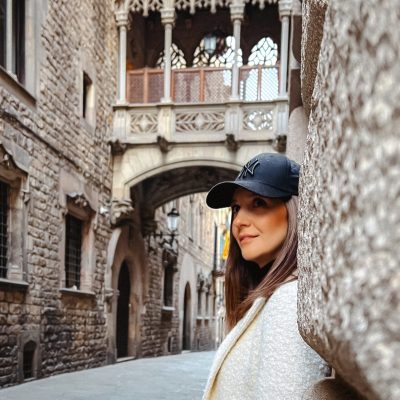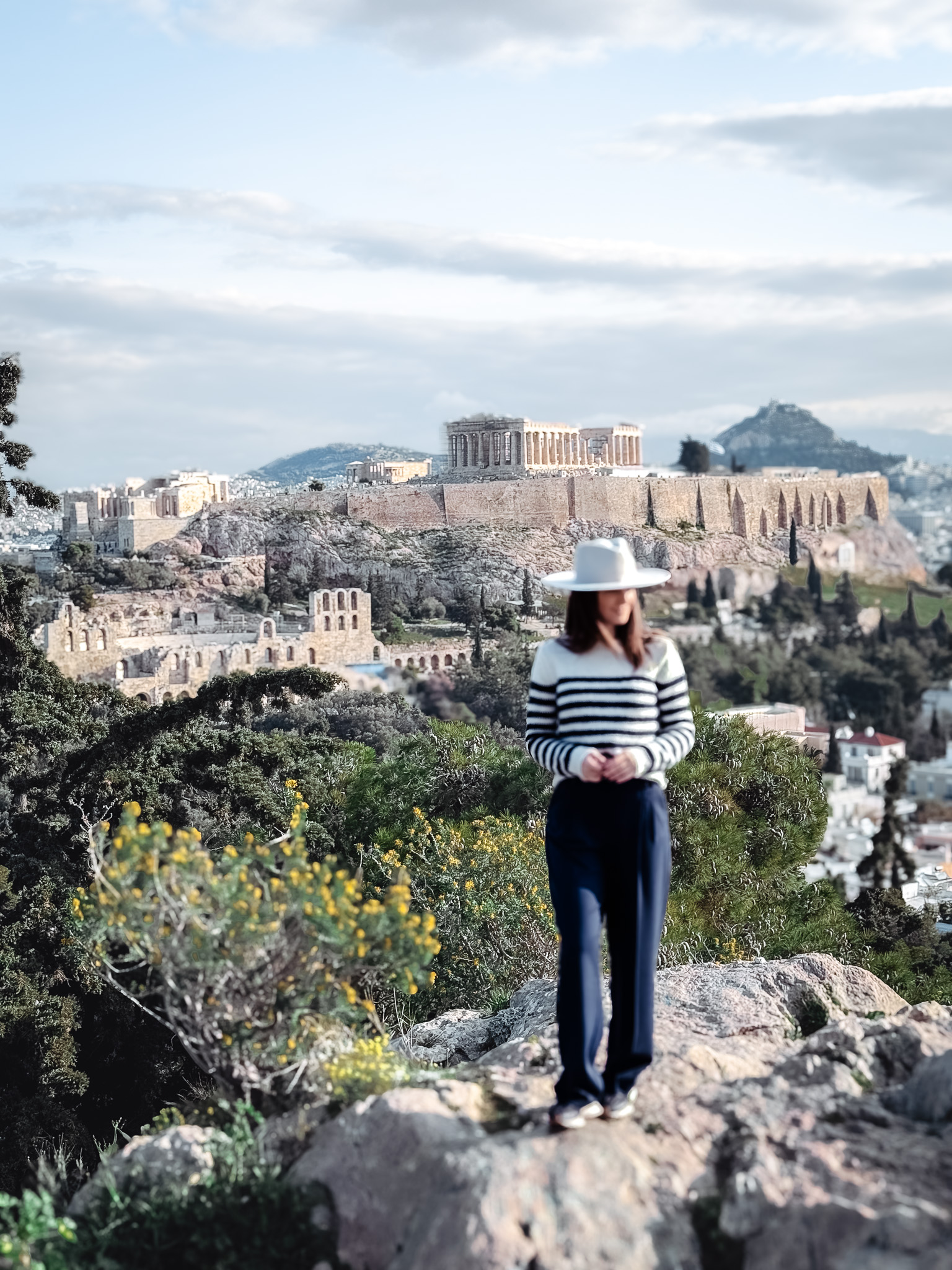Kinderdijk is a picturesque windmill village located 40 minutes from Rotterdam that’s very scenic no matter the season. However, Kinderdijk windmills are so much more than a postcard-worthy destination.
Visiting Kinderdijk, a UNESCO World Heritage site, is a unique opportunity to learn the history of the Netherlands’ struggles against rising water levels. This is where you can learn about the complete history of water management, over the many centuries, in one location. It’s also your chance to see what life was like in the Netherlands centuries ago and get to know a different side of the Netherlands that you won’t find in the cities.
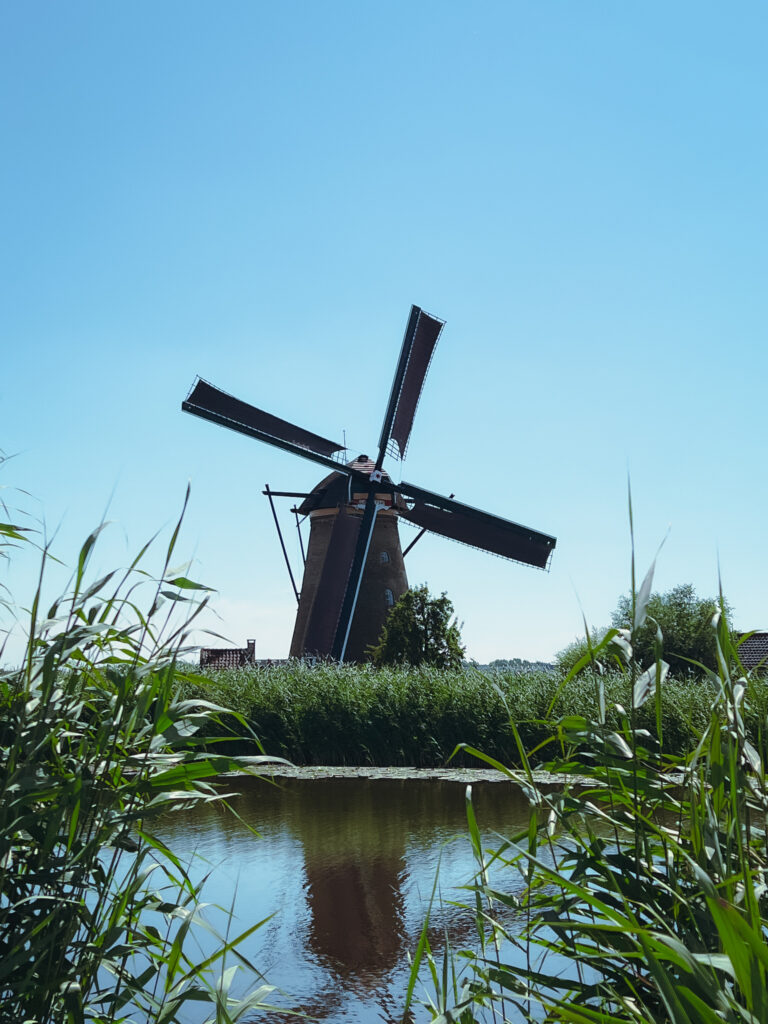
About Kinderdijk
The area south of Rotterdam was once reclaimed from the river water, and an ingenious system was created in Kinderdijk to keep all the water out, consisting of dikes, canals, and windmills.
The 19 mills and a pumping station system were built in 1868. Over the centuries, this system has been further modernised, and as it is unique in its kind, the entire area was included on the UNESCO World Heritage List in 1997.
Kinderdijk windmills
Originally there were 20 windmills at Kinderdijk, and now 19 of them remain. However, you can only visit two of them inside: Nederwaard and Blokweer. Most other windmills are private property.
Blokker is the oldest windmill of Kinderdijk and dates from the early 16th century. The other 18 windmills, which now form the unique Kinderdijk village, date from 1738 – 1740. They were built as part of a drainage system to drain the excess water from the area into the river, and then into the sea. For many centuries the Dutch windmills played an essential role in the drainage and reclamation of land in the Netherlands.
Interesting facts: In the past, the millers used the windmills’ sails to communicate. The sails’ position indicated whether the mills should be operated or whether the millers had taken a break. Further, they were also used to share news such as birth, marriage, or death in the family. On festive occasions, the windmills were decorated with colorful flags.
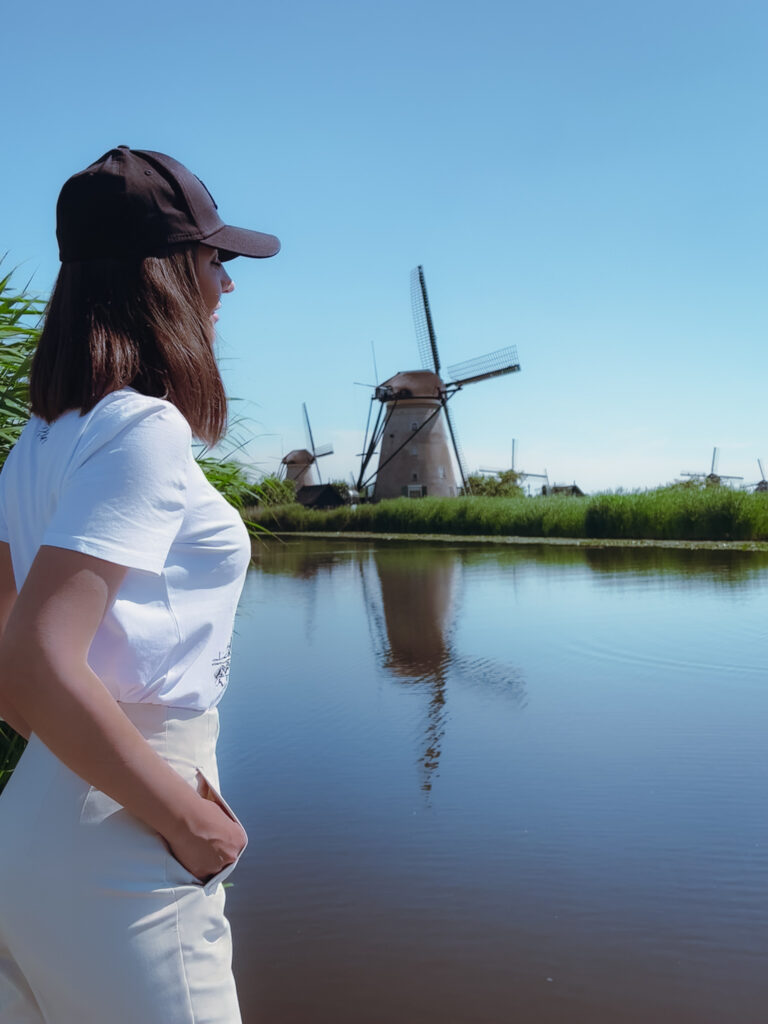
Visiting Kinderdijk
Kinderdijk is free to visit any time of the day year-round.
There is no good or bad season to visit. Spring or fall are quieter than the summertime and less crowded. There is hardly anyone in the winter, but it can be just as magical. I visited Kinderdijk windmills on a dry, sunny day in June, which was beautiful.
The site can be accessed free of charge, but you will need a ticket for the museum windmills and the pumping stations.
Opening times: 09:00 – 17:30 April – October and 10:00 – 16:00 November – March
Tickets: 16€; 18.50€ on weekends (ticket includes a short film at the visitor’s center, the engine room in the Wisboom pumping station, and the entrance to the two museum mils.)
Visit the official website for more details.
Pro tip: The best time to visit Kinderdijk windmills is either early in the morning or late in the afternoon. Sunsets are magical here. Remember that the museums close pretty early, so see those first.
You can explore the Kinderdijk in just an hour or spend half a day. If you want to see all the windmills and the museums and take a scenic boat tour, you’ll need at least half a day.
There are several small cafes with bathroom facilities at different locations in Kinderdijk. There are also several bigger restaurants where you can have lunch or dinner. Alternatively, you can bring your own picnic, and there is a nice picnic area at the Blokweer windmill.
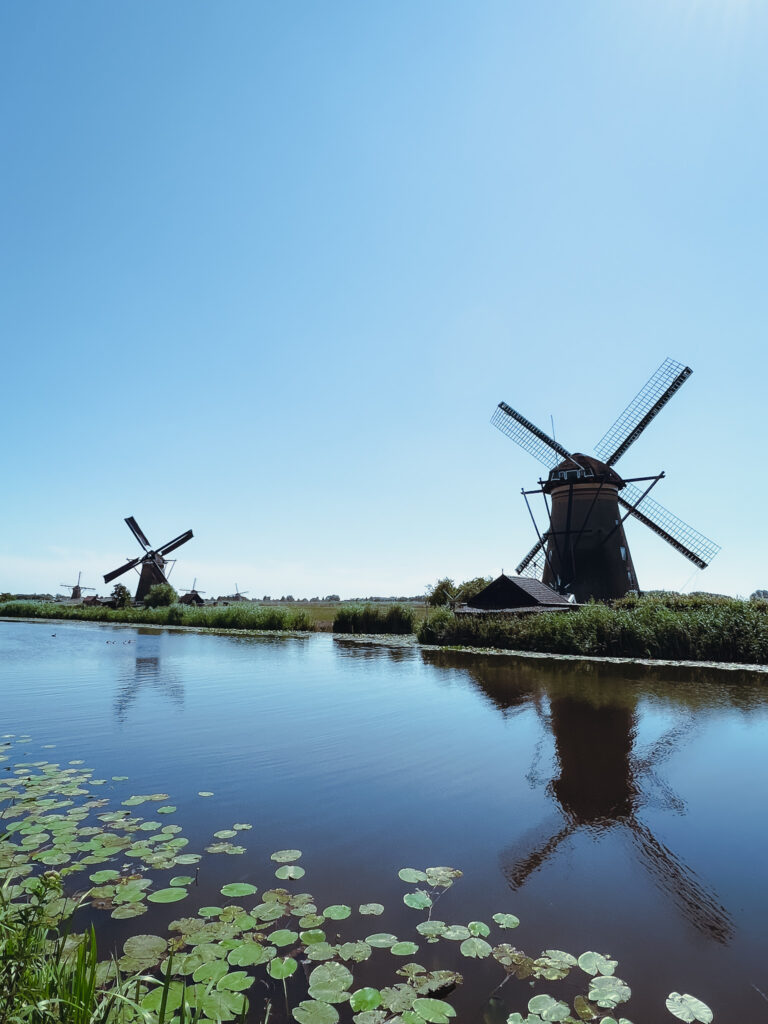
How to get to Kinderdijk
Kinderdijk is located just 15 km east of Rotterdam and is just a 1.5 hour’s drive from Amsterdam.
By car: You can visit Kinderdijk by renting a car. Be prepared for heavy traffic if traveling on the weekend or in the high season. Finding a parking spot might take a lot of work as well.
By waterbus: Getting to Kinderdijk by waterbus from Rotterdam is the most popular way. In the summer, there are direct connections from Rotterdam to Kinderdijk. You’ll have to switch boats in the lower season to reach the final destination. Since the pandemic, the direct route has been canceled. Here you can find more information about taking the waterbus to Kinderdijk.
By bus: You can also take a bus from Rotterdam or Dordrecht to Kinderdijk. Here you can find more information about bus connections to Kinderdijk.
Guided tour: Another option to visit the Kinderdijk windmill is guided tours. A day trip from the city will be perfect if you visit Amsterdam or Rotterdam. Here you can find Kinderdijk guided tour offers.
By bike: Do it like the locals and rent a bike to get to Kinderdijk! It’s a one-hour ride from Rotterdam and quite an adventure!

What to see in Kinderdijk
At Kinderdijk, you can visit two windmill museums, Nederwaards, and Blokweer. Also, watch the multi-screen film in the second pumping station and an engine room in the Wisboom pumping station.
Pumping station De Fabriek
Start your visit at De Fabriek and watch the multi-screen film that takes you on a virtual trip through the centuries-old history of Kinderdijk. You will learn about the history of the area before exploring it!
The film is well done and available in different languages, including Dutch, English, Japanese, French, and German.
Blokweer Museum Mill
Blokweer Museum Mill was built in 1630 and is one of the oldest in the area. Nowadays, it is a museum where you can experience what life was like in the Netherlands from the beginning to mid 20th century.
In the peak season, you’ll meet the millers wearing traditional garments and can take a short tour of the mill.
Nederwaard Museum Mill
The Nederwaard Museum Mill dates back to 1738, and this mill was home to the Hoek family for several generations. Visiting here is like stepping back in time and experiencing the life of miller’s families used to be. Inside, you’ll find historical photos and all kinds of household items used by real miller families.
Wisboom Pumping Station
The Wisboom Pumping Station is one of the historical buildings you should visit inside. This pumping station dates back to 1868, and it was in operation till 1995 when a new pumping station replaced it.
Nowadays, it serves as a museum.
Don’t miss the original engine room!
Getting around Kinderdijk
Kinderdijk site is spread over several kilometers. There are lovely flat walkways/bicycle paths, so you can explore on foot or by bike. You can also take a boat tour, and there are two options: Canal Hopper and Canal Cruiser. You can also rent a bike, and there are a few places in the village where you can rent one.
Canal Hopper
The Canal Hopper boat tour runs all year round, about 30 minutes if you don’t disembark anywhere. This boat serves as a hop-on hop-off boat and stops at all the main sights in the area.
Canal Cruiser
The Canal Cruiser operates in high season, from April to October. This is a scenic boat tour of the area, starting and ending at the jetty next to the pedestrian bridge near Kinderdijk Visitor’s center.
The Cruiser boat tour goes a bit further than the Hopper, but it doesn’t stop along the way. It’s a great way to see the area for those who are short on time and those who want a different view of the windmills from the water.
Pro tip: Both boat tours allow dogs on a leash!
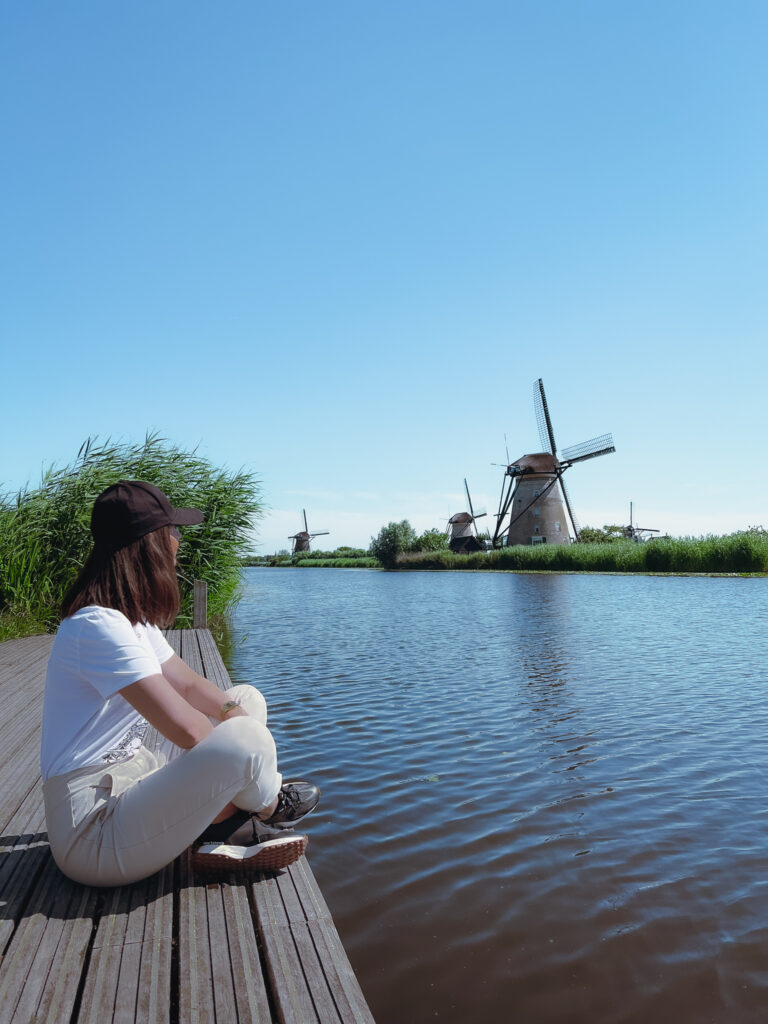
Kinderdijk or Zaanse Schans?
If you’re deciding between Zaanse Schans windmill village and Kinderdijk windmills, here are a few points that might help you choose:
- Zaanse Schans windmill village is located right next to the city of Zaandam, while Kinderdijk is situated between the green meadows.
- There is more to explore at Zaanse Schans, offering a historic village experience, but Kinderdijk has much more windmills than Zaanse Schans.
- Kinderdijk is close to Rotterdam, but Zaanse Schans is closer to Amsterdam and has many more visitors.
- The Kinderdijk windmills offer a more authentic experience as they were built in this location, and the Zaanse Schans windmills were relocated here.
- The Zaanse Schans windmills were used for different purposes, like grinding spices and making oil, while the Kinderdijk windmills were all built for the same water-controlling purpose. Because of this, the Zaanse Schans windmills have names, but the Kinderdijk windmills only have numbers.
- Kinderdijk offers a much better photo experience with the windmills reflections in the water and the stunning golden colors around sunrise or sunset.
- It’s easier to park at Zaanse Schans with its big parking, while Kinderdijk only has big parking outside the village.
- You can reach Kinderdijk by waterbus from Rotterdam or Dordrecht, a unique local experience.
If you have the time, visit both Zaanse Schans windmill village and Kiderdijk, as each is beautiful and has different things to offer. I know I loved them both!



